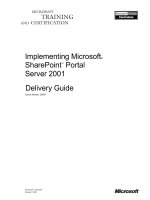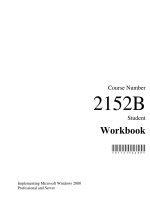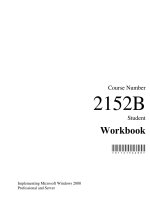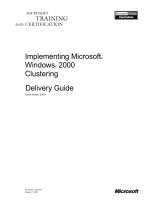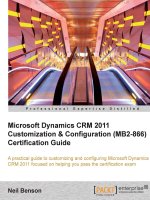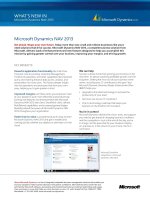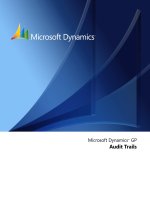Implementing microsoft dynamics NAV
Bạn đang xem bản rút gọn của tài liệu. Xem và tải ngay bản đầy đủ của tài liệu tại đây (9.9 MB, 491 trang )
[1]
Implementing Microsoft
Dynamics NAV
Third Edition
Explore the capabilities of Dynamics NAV 2016 and
discover all you need to implement it
Alex Chow
Laura Nicolàs Lorente
Cristina Nicolàs Lorente
Vjekoslav Babić
David Roys
professional expertise distilled
P U B L I S H I N G
BIRMINGHAM - MUMBAI
Implementing Microsoft Dynamics NAV
Third Edition
Copyright © 2016 Packt Publishing
All rights reserved. No part of this book may be reproduced, stored in a retrieval
system, or transmitted in any form or by any means, without the prior written
permission of the publisher, except in the case of brief quotations embedded in
critical articles or reviews.
Every effort has been made in the preparation of this book to ensure the accuracy
of the information presented. However, the information contained in this book is
sold without warranty, either express or implied. Neither the authors, nor Packt
Publishing, and its dealers and distributors will be held liable for any damages
caused or alleged to be caused directly or indirectly by this book.
Packt Publishing has endeavored to provide trademark information about all of the
companies and products mentioned in this book by the appropriate use of capitals.
However, Packt Publishing cannot guarantee the accuracy of this information.
First Edition: January 2009
Second Edition: February 2013
Third Published: April 2016
Production reference: 1050416
Published by Packt Publishing Ltd.
Livery Place
35 Livery Street
Birmingham B3 2PB, UK.
ISBN 978-1-78439-755-5
www.packtpub.com
Credits
Authors
Alex Chow
Project Coordinator
Judie Jose
Laura Nicolàs Lorente
Cristina Nicolàs Lorente
Vjekoslav Babić
David Roys
Reviewers
Stefano Demiliani
Tony Hemy
Acquisition Editor
Manish Nainani
Content Development Editor
Abhishek Jadhav
Technical Editors
Ryan Kochery
Menza Mathew
Deepti Tuscano
Copy Editors
Kausambhi Majumdar
Vikrant Phadke
Alpha Singh
Proofreader
Safis Editing
Indexer
Monica Ajmera Mehta
Graphics
Disha Haria
Production Coordinator
Conidon Miranda
Cover Work
Conidon Miranda
About the Authors
Alex Chow has been working with Microsoft Dynamics NAV, formerly Navision,
since 1999. Over the years, he has conducted hundreds of implementations across
multiple industries. His customers range from $2-million-a-year small enterprises to
$500-million-a-year multinational corporations.
Over the course of his Dynamics NAV career, he has often been designated as
the primary person responsible for the success and failure of Dynamics NAV
implementations. The fact that Alex is still in the Dynamics NAV business means
that he's been pretty lucky so far. His extensive career in the Dynamics NAV
business is evidence of his success rate and expertise.
With a background in implementing all functions and modules inside and outside
of Microsoft Dynamics NAV, Alex has encountered and resolved the most practical
to the most complex requirements and business rules. Through these experiences, he
has learned that sometimes you have to be a little crazy to have a competitive edge.
Believing that sharing these experiences and knowledge would benefit the Dynamics
NAV community, Alex writes about his journey at www.dynamicsnavconsultant.
com. He founded AP Commerce (www.apcommerce.com) in 2005. It is a full-service
Dynamics NAV service center. In addition, Alex has written a book about Dynamics
NAV titled Getting Started with Dynamics NAV 2013 Application Development by
Packt Publishing.
He lives in southern California with his beautiful wife and two lovely daughters.
He considers himself the luckiest man in the world.
Laura Nicolàs Lorente started working with Dynamics NAV back in 2005, first
in the support department, mostly solving functional issues and doubts. She soon
jumped to full deployment: consulting, analysis, development, implementation,
migration, training, and support. Right from the beginning, she realized that it was
very important for a Dynamics NAV consultant to have deep knowledge of business
workflows. Technical skills are just not enough. So, she started to train herself in
accounting, taxation, supply chains, logistics, and so on.
Laura discovered a whole new world and she found it very interesting. After having
enough consultancy experience, she got a chance to manage the first project on her
own. And then she realized that even tech and business knowledge are not enough—
she also needed management skills. That is why, after reading different management
books and trying different approaches on the projects she worked on, she decided
to deepen her knowledge by taking a master's degree in project management.
Laura is now transitioning to agile management and agile development for better
project success. She continues her training in the three areas (technology, business
workflows, and management) whenever she gets the chance. The Internet is a huge
source of inspiration for her: groups, forums, blogs, books, and so on. She also
contributes by sharing her knowledge and experience with the Spanish Dynamics
NAV community. Laura is also the coauthor of the book Implementing Microsoft
Dynamics NAV 2013, Packt Publishing which had really good feedback from different
Dynamics NAV experts.
Cristina Nicolàs Lorente has been working with Dynamics NAV since 2005. She
started in the ERP world as a developer, but soon evolved into a complete Dynamics
NAV professional, doing all the tasks involved in Dynamics NAV implementations:
consultancy, analysis, development, implementation, training, and support to end
users. When Cristina started developing solutions for Dynamics NAV, she had no
idea about accounting or any kind of business workflow. They don't teach those
kinds of things for a technical university career. Soon, she discovered that it is
important to know the set of tools used, but even more important to understand the
meaning of whatever you develop. Without knowing the accounting rules, practices,
and legal requirements, it is impossible to develop useful accounting functionalities
even if you are the best developer of all. Only when you fully understand a
company's processes will you be able to do the appropriate developments. Having
that in mind, Cristina has taken courses in accounting, warehouse management,
and operations management. She is also willing to take courses on any other
company-related topics. She thinks that the best way to learn is to teach what you
are learning to someone else. She has actually learned almost everything she knows
about Dynamics NAV by responding to user questions on Internet forums, by
writing a blog about Dynamics NAV, and of course by writing the book you have
in your hands. When you have to write about something, you have to experiment,
try, investigate, and read. It is definitely the best way to learn. Cristina is also the
coauthor of the book Implementing Microsoft Dynamics NAV 2013, Packt Publishing.
Vjekoslav Babić is a Microsoft Dynamics NAV expert, consultant, and architect
with 18 years of experience in the IT industry and 14 years of experience delivering
project success on large-scale, international, and high-risk and implementations
of Microsoft Dynamics solutions. He has project experience in various industries,
including retail, telecommunications, insurance, food and beverages, manufacturing,
distribution, and many more. He has been awarded the Microsoft Most Valuable
Professional award since 2010. Vjekoslav is an avid author and has published
more than 400 technical articles about software development, database design, and
Internet technologies in a number of online and printed magazines, as well as on
his blog at He speaks regularly at Microsoft Dynamics NAV
conferences worldwide.
Based in Zagreb, Croatia, he runs his own Microsoft Dynamics NAV consultancy
business.
You can contact Vjekoslav through his blog at />
David Roys has worked in the computer industry since 1992 and currently works
as a Dynamics NAV programmer and consultant for Intergen, a leading Microsoft
Gold Partner. He is the Dynamics Presidents Club member in New Zealand.
After coauthoring the original Implementing Microsoft Dynamics NAV book by
Packt Publishing in 2009, David has written two novels.
About the Reviewers
Stefano Demiliani is a Microsoft Certified Solution Developer (MCSD), MCAD,
MCTS on Microsoft Dynamics NAV, MCTS on SharePoint, MCTS on SQL Server,
and a long-time expert on other Microsoft-related technologies. He has a master's
degree in computer engineering from the Politecnico of Turin, Italy.
He works as a senior project manager and solution developer for EID (http://
www.eid.it), a company of the Navlab group (), one of
the biggest Microsoft Dynamics groups in Italy (where he's also the chief technical
officer). Stefano has a long-time experience of Microsoft Dynamics NAV, since the
first versions of the ERP. His main activity is architecting and developing enterprise
solutions based on the entire stack of Microsoft technologies (Microsoft Dynamics
NAV, Microsoft SharePoint, Azure and .NET applications in general, OLAP, and
BI solutions for data analysis), and he's often focused on engineering distributed
service-based applications.
He works as a full-time NAV consultant, having spent more than 15 years on
international NAV projects, and is available for architecting solutions based on
Microsoft's ERP and for NAV database tuning and optimization (performance and
locking management). He's the author of different Microsoft-certified NAV add-ons
(such as the first cost accounting add-on on NAV).
Stefano has written many articles and blogs on different Microsoft-related topics,
and he's frequently involved in consulting and teaching. He has worked with Packt
Publishing in the past for many Microsoft Dynamics NAV-related books.
You can get more details and keep in touch with him by going to http://www.
demiliani.com or via Twitter (@demiliani) or LinkedIn.
Tony Hemy has been deeply rooted in Microsoft Dynamics NAV from the age of
16. Over the years, he has architected and customized Microsoft Dynamics NAV
solutions for global organizations such as Warner Brothers and Viacom, earning an
outstanding reputation and the role of technical reviewer on four books published on
Dynamics NAV. Tony also served for more than 5 years as a reserve soldier with the
British Army, where he expanded not only his technical skills but also his personal
skills, which have contributed to his disciplined work ethic and his determination to
always do things right.
His hands-on development experience with Microsoft Dynamics has given him an
exceptional ability to help clients define the proper requirements that will enable
them to achieve their objectives. He has delivered extended capabilities through
every version, every module, and every feature of Dynamics NAV, building
thousands of unique configurations along the way. Tony also oversees software
development, where he manages and mentors a talented development team and
facilitates the best practices and standards that ensure clients receive the highest
quality solutions and service. Tony is well-traveled, well-rounded, and well-liked for
his personable nature and "no shortcuts" approach, whether he is writing complex
code or coaching his team.
www.PacktPub.com
Support files, eBooks, discount offers,
and more
Did you know that Packt offers eBook versions of every book published, with PDF
and ePub files available? You can upgrade to the eBook version at www.PacktPub.
com and as a print book customer, you are entitled to a discount on the eBook copy.
Get in touch with us at for more details.
At www.PacktPub.com, you can also read a collection of free technical articles, sign
up for a range of free newsletters and receive exclusive discounts and offers on Packt
books and eBooks.
TM
/>
Do you need instant solutions to your IT questions? PacktLib is Packt's online digital
book library. Here, you can search, access, and read Packt's entire library of books.
Why subscribe?
•
Fully searchable across every book published by Packt
•
Copy and paste, print, and bookmark content
•
On demand and accessible via a web browser
Instant updates on new Packt books
Get notified! Find out when new books are published by following @
PacktEnterprise on Twitter or the Packt Enterprise Facebook page.
Table of Contents
Preface
Chapter 1: Exploring Microsoft Dynamics NAV – An Introduction
Understanding Microsoft Dynamics NAV
The functional areas within Dynamics NAV
History of Dynamics NAV
Functional areas
Financial Management
General Ledger
G/L budgets
Account Schedules
Cash Management
Fixed Assets
VAT reporting and intrastat
Sales tax
Intercompany transactions
Consolidation
Multicurrency
xi
1
2
3
5
9
10
11
11
12
14
14
15
15
17
18
18
Sales and marketing
19
Purchase
25
Approvals
26
Customers
Order processing
Approvals
Pricing
Marketing
20
21
23
24
24
Vendors
Order processing
25
25
Pricing
Planning
26
26
[i]
Table of Contents
Warehouse
28
Manufacturing
33
Job
39
Resource planning
44
Service
46
Human resources
52
Items
Locations
Transfer orders
Assembly
Pick and put-away
Inventory
28
30
30
30
31
31
Product design
Capacities
Planning
Execution
Costing
Subcontracting
34
36
37
38
38
39
Job card
Phases and tasks
Planning
Time sheet
Invoice jobs
Work in process (WIP)
40
40
41
43
43
43
Resource card
Pricing
44
46
Service items
Contracts
Price management
Service orders
Service tasks
Fault reporting
47
49
49
51
51
52
Employees
Absence registration
Country localizations
53
54
54
Vertical and horizontal solutions
Accessing Dynamics NAV
Windows client
Web client
Tablet client
SharePoint client
Web Services
Development Environment
Summary
54
55
55
57
58
59
59
60
62
[ ii ]
Table of Contents
Chapter 2: What's New in NAV 2016?
Application changes
Improvements for the application users
Cues with color indicator
Mandatory fields
Simplified user interface for small businesses
Tablet client
New application features
Automatic payment and bank reconciliation
Signing up for the Bank Data Conversion Service
Reconciling payments automatically
Reconciling bank statements automatically
Social Listening
Power Business Intelligence
RapidStart services
Schedule reports
E-mailing documents
Document exchange service (OCR Services)
Exchange rates update
Native integration with Dynamics CRM
Universal app
Workflow management
Posting Preview
Deferrals
Development changes
Document reporting
Upgrade automation – an overview
Upgrade automation – the application code
Upgrade automation – data
Enhancement in security and encryption
Changes to C/AL functions, data types, properties, and triggers
.NET interoperability
Enhancements in RoleTailored client control add-ins
IT changes
Dynamics NAV Server administration
Windows PowerShell cmdlets
Summary
Chapter 3: Dynamics NAV – General Considerations
The data model
Master data
Documents
Journals
[ iii ]
63
63
64
64
65
65
67
69
69
69
71
71
72
72
72
74
76
77
78
78
78
78
79
79
79
80
83
83
83
84
84
90
90
91
91
91
95
97
98
98
99
104
Table of Contents
Entries
108
Creating ledger entries
Combining all concepts
No save button
The main advantage
When is the data verified?
The main drawback
The posting routines
Posted data cannot be modified (or deleted)
Navigating through your data
The Navigate functionality
Other ways to browse data
Sorting on list pages
Filtering for the data you need
Saving views for the filters you've set
Real-time data gathering – the SIFT technology
Everything leads to accounting
The Dynamics NAV database
The TableRelation property
Coded data rules
Summary
Chapter 4: The Implementation Process – From the Reseller
What is an implementation?
Methodology
The Waterfall approach
The Agile approach
Using the best of both
Microsoft Dynamics Sure Step
Project types based on the Waterfall approach
The Agile project type
Roles
Salesperson
Project manager
Business consultant
Key users
Analyst
Developer
Implementer
End users
Summarizing the roles
[ iv ]
111
116
117
118
119
120
120
121
123
123
125
127
127
129
131
132
133
134
136
138
139
140
142
145
147
148
148
149
153
155
156
156
156
157
158
159
159
159
160
Table of Contents
Phases
Presales
Getting the project requirements
Designing the solution
Configuration
Modifying standard Dynamics NAV functionality
New functionalities
Data migration
Development
Deployment
Software and hardware installation
Configuration
Data migration
User-acceptance test
End users' training
Go-live!
161
161
162
165
165
168
168
168
168
169
169
170
170
171
171
171
Post Implementation Support
Summary
172
173
Chapter 5: The Implementation Process on the Customer Side
175
Chapter 6: Migrating Data
189
Definition of goals
Measuring goals
Defining the internal processes
Questions to be asked
Improve before automating
Getting the requirements
Change management
Get involved in testing the system
Involve end users
Summary
Tools to migrate data
RapidStart Services
Creating a new company using PowerShell
Changing the profile to RapidStart Services Implementer
Using the configuration wizard
Creating a data conversion package
Configuration worksheet
Using Excel templates
Configuration templates
Configuration questionnaire
Summarizing RapidStart Services
[v]
176
177
179
179
183
183
185
186
187
188
189
190
191
193
194
195
200
205
208
210
212
Table of Contents
Using XMLports to migrate data
213
The XMLport structure
Running the XMLport
Writing code inside the XMLport
214
216
217
Writing your own tools
Converting data from the old system to Dynamics NAV's needs
Fields particular to Microsoft Dynamics NAV
Master data
Open entries
Customer entries
Vendor entries
Bank entries
Item entries
Fixed-asset entries
General Ledger balances
Historical data
Open documents
Choosing a go-live date
Going live at the beginning of the fiscal year
223
223
224
225
226
226
231
231
231
233
235
235
236
239
239
Going live in the middle of a fiscal year
Summary
240
241
What cons do we have?
Chapter 7: Upgrading Microsoft Dynamics NAV
Upgrading philosophy
Upgrades prior to Dynamics NAV 2013
Upgrades from Dynamics NAV 2013 forward
Upgrading process checklist
Upgrading from 2013, 2013 R2, or 2015
Technical upgrade (converting the database)
240
243
244
245
245
246
247
247
Upgrading from 2009, 2009 SP1, or 2009 R2
259
Upgrading from 5.0 or 5.0 SP1
261
Upgrading from 4.0, 4.0 SP1, 4.0 SP2, or 4.0 SP3
263
Upgrading from 3.60 or 3.70
266
Upgrading the 2009 application code
Upgrading the 2009 data
Upgrading the 5.0 application code
Upgrading the 5.0 data
Upgrading the 4.0 application code
Upgrading the 4.0 data
Upgrading the 3.60 or 3.70 application code
Upgrading the 3.60 or 3.70 data
[ vi ]
259
260
261
262
264
265
267
268
Table of Contents
Upgrading steps to NAV 2013
Preparing to upgrade
269
269
Migrating to SQL Server
Testing the database
270
270
Upgrading the application code
Getting object versions
Converting objects to the Dynamics NAV 2013 format
Carrying out customizations to the new version
Transforming forms to pages
Transforming reports
271
271
272
273
273
274
Upgrading the data
Upgrading tools
Upgrade toolkit
Text format upgrade
Form transformation
Report transformation
274
275
275
276
278
278
Comparing text tools
MergeTool
280
281
Upgrading hybrid reports
Upgrading classic reports
279
280
Downloading MergeTool
Installing MergeTool
Using MergeTool
281
281
282
Summary
Chapter 8: Development Considerations
Setup versus customization
Data model principles
Basic objects
Object elements
292
293
293
295
296
299
How tables are structured
302
The structure of pages
313
Understanding table structures
The final picture
304
312
Understanding page structures
The posting process
The codeunit structure for sales posting
The codeunit structure for General Journal posting
Where to write customized code
Validating fields
Batch jobs
Formatting customized code
Summary
[ vii ]
314
326
326
327
328
328
329
330
330
Table of Contents
Chapter 9: Functional Changes on Existing Implementations
General guidelines
What is a functional change?
The Requisition Worksheet
Fixed Assets
Item Tracking
Extending a customized functionality
Interactions with other functionalities
The Requisition Worksheet
Fixed Assets
Item Tracking
Creating a new item
Creating and posting a purchase order for the new item
Creating and posting a sales order for the new item
Turning on Item Tracking for the new item
Extending a customized functionality
Writing a to-do list to implement a change
The Requisition Worksheet
Fixed Assets
Item Tracking
Extending a customized functionality
Choosing the right time
The Requisition Worksheet
Fixed Assets
Item Tracking
Extending a customized functionality
Planning the change
The Requisition Worksheet
Fixed Assets
Item Tracking
Extending a customized functionality
Summary
Chapter 10: Data Analysis and Reporting
Using filters and FlowFilters
Creating views
Statistics
Charts
The Show as Chart option
Adding charts to the Role Center page
Creating and configuring charts
[ viii ]
331
331
332
332
333
333
334
334
334
335
336
338
339
341
341
342
343
343
345
347
348
349
350
350
350
351
351
352
354
356
357
359
361
362
364
366
368
368
369
371
Table of Contents
Using reports
Finding reports
Running reports
Types of reports
373
374
376
379
Account schedules
Analysis views
Understanding dimensions
383
386
387
Creating an analysis view
Updating analysis views
Using analysis views
394
397
398
List reports
Test reports
Posting reports
Transaction reports
Document reports
Other reports
380
380
380
381
381
382
Setting up new dimensions
Categorizing dimensions
Accessing dimensions
388
389
391
Analysis by dimensions
Analysis views as a source for account schedules
398
400
Extracting data
Sending data to Microsoft Office applications
401
402
Extracting data through web services
Other ways to extract Dynamics NAV data
Understanding report development
Reports anatomy
Defining the dataset
Designing the visual layout
Summary
404
405
405
405
407
409
411
Sending data to Microsoft Word
Sending data to Microsoft Excel
Chapter 11: Debugging
The art of debugging
Debugging in Dynamics NAV 2016
Break Rules
Placing breakpoints
From the Object Designer
In the current statement of the debugger
Conditional breakpoint
Debugger Breakpoint List
[ ix ]
403
404
413
413
414
416
417
417
418
420
420
Table of Contents
Line-by-line execution
The Step Into option
The Step Over option
The Step Out option
The Continue option
The Call Stack FactBox
The Watches FactBox
Adding variables from the Debugger Variables List window
Adding variables from the code viewer
Summary
Chapter 12: Popular Reporting Options with Microsoft
Dynamics NAV
What is a query?
Query Designer
Defining our first query
Adding additional data to the query
Charts
Web services
External applications
Excel and PowerPivot
Power BI
Jet Reports Express
Downloading Jet Reports Express
Installing Jet Reports Express
Report pack for Jet Reports Express
Summary
Index
[x]
421
422
423
424
425
426
427
428
429
430
431
432
433
434
439
441
443
446
446
449
452
452
453
453
454
455
Preface
Let me start out by saying congratulations on your decision to work with Dynamics
NAV. When I started working with Dynamics NAV (formerly known as Navision)
back in 1999, Dynamics NAV was nothing more than an accounting system out of
Denmark. After a couple of releases, acquisition by Microsoft, and a couple more
releases, Dynamics NAV has become a full ERP (enterprise resource planning)
software with rich functionalities. With every release, we see improvements in the
technical aspect as well as the functionality aspect. And
they're not done yet.
At the time of writing, Dynamics NAV's installation base is 110,000 companies.
No other ERP software for the small and medium-sized market comes close to that
number.
In addition, Dynamics NAV has a wide range of add-on solutions available. Most
of these add-ons are built directly within the Dynamics NAV environment with the
same user interface. So, using these add-ons, your company will not need to learn
any other new software.
One of the main selling points of Dynamic NAV from the very beginning is the
ability to customize it exactly the way you run your business. Because of its
flexibility, you can find a lot of tutorials and explanations on how to develop specific
tasks, but not a lot of tutorials on how to create a project from scratch.
To take advantage of the flexibility that's built into Dynamics NAV, a deep
understanding of the standard application is required. Just because you're able to
completely rewrite Dynamics NAV does not mean you should. Without knowing
what you have out of the box, you may end up creating a function that's already part
of the standard system, wasting your valuable time and resources.
[ xi ]
Preface
What this book covers
Chapter 1, Exploring Microsoft Dynamics NAV – An Introduction, introduces you to
what an ERP is and what you can expect from Dynamics NAV. It introduces all
the functional areas found in Dynamics NAV 2016 and the different environments
available, such as the Windows client, the web client, the SharePoint framework,
or web services. For the nostalgic, we have also included details on the history of
Dynamics NAV.
Chapter 2, What's New in NAV 2016?, gives an overview of the changes made within
the application. Dynamics NAV 2016 introduces quite a few new features, that is,
new functionalities and tools available for the end user, such as the improvements
that can be made to the Windows client or the assembly management feature. The
chapter also covers development and IT changes.
Chapter 3, Dynamics NAV – General Considerations, is all about the Dynamics NAV
structure, its data model, how information flows, how posting routines works, how
users can navigate through their data, why everything leads to accounting, and how
data integrity is approached.
Knowing the Dynamics NAV philosophy on how things are done is important for
everyone. It is important for users because they need to know how to work with
Dynamics NAV and also need to be aware of the consequences of what they do; it is
also important for consultants, analysts, and developers because they need to use the
same structures and the same way to make information flow when developing new
functionalities.
Chapter 4, The Implementation Process (from the Reseller), explains the meaning
of implementation and covers different methodologies that can be applied
while implementing Dynamics NAV. Several people may get involved in an
implementation process, each one playing their own role and performing different
jobs. This chapter also covers the phases and tasks needed to complete a Dynamics
NAV implementation, from presales to deployment.
Chapter 5, The Implementation Process on the Customer Side, explains what is expected
from the company's team (users, key users, and project leader), and how to deal with
the change that the new ERP will make for everyone in the company. For a really
successful implementation of Dynamics NAV, the company that NAV has been
implemented for has to actively participate in the project.
Chapter 6, Migrating Data, covers the tools that can be used to import data into
Dynamics NAV, such as RapidStart services or XMLports. Companies may be new to
Dynamics NAV, but they are usually not new companies. They have been working
for a while and they have all kinds of data, such as their customers, vendors, items,
and accounting information.
[ xii ]
Preface
This chapter also explains which kind of data is commonly migrated to Dynamics
NAV and the strategies used to migrate it. With a step-by-step example, the
chapter enables you to migrate master data, open entries, historical data, and open
documents.
Chapter 7, Upgrading Microsoft Dynamics NAV, explains the migration process
from Versions 3.xx, 4.xx, 5.xx, 2009, and 2013. Upgrading to a different version of
Dynamics NAV is not a "Next-Next-Finish" process. It is a complete project that has
to be planned and executed carefully.
We will explain the steps that have to be followed for all the versions and the tools
that are out there to help us get through the whole process.
Chapter 8, Development Considerations, covers the main development considerations
that should be taken into account when developing for Dynamics NAV. This
includes a deep explanation of the data model principles in Dynamics NAV and how
the posting processes are designed. It also includes explanations about where and
how to write customized code.
Almost every Dynamics NAV implementation implies development. The customized
code must fit inside the application's standard code and it should look as if it were
part of the standard. This makes it easier for the user to understand how customized
modules work and for partners to support them.
Chapter 9, Functional Changes in Existing Implementations, explains how to handle
functional changes in existing implementations with a set of four examples. After
working with Dynamics NAV for a while, companies may ask for functional changes
on their implementations, such as adding some extra developments or starting to
use an existing functionality. Some extra things have to be taken into account when
dealing with such projects.
Chapter 10, Data Analysis and Reporting, provides an overview of the tools available
to analyze Dynamics NAV data, both inside and outside the application, such as
the use of filters and FlowFilters, statistics, charts, existing reports, analysis views,
account schedules, or how to extract data from Dynamics NAV. Data analysis and
reporting is an important part of the management of a company.
This chapter also includes a report development section that is meant to explain the
anatomy of reports, to show how to define your dataset, and to show how the visual
layout is designed.
Chapter 11, Debugging, covers debugging in Microsoft Dynamics NAV. Conditional
breakpoints, debug other user sessions, and debug C/AL code in the RTC client
instead of incomprehensible C# code. All these features will convert the debugging
experience into a happy experience.
[ xiii ]
Preface
Chapter 12, Popular Reporting Options with Microsoft Dynamics NAV, explains what
other popular options you can utilize with Dynamics NAV. There is a standard NAV
reporting tool, but with the advances in reporting technology, such as BI, Excel, and
so on, there are a lot of other options you can utilize to have your Dynamics NAV
data come alive.
What you need for this book
To successfully follow the examples in this book, you will need to install Microsoft
Dynamics NAV 2016.
Who this book is for
This book is meant for Dynamics NAV implementation consultants, project
managers, and developers who want to get a deeper view of what Dynamics NAV
can offer.
It is also meant for Dynamics NAV developers who want to learn more about the
whole application.
And finally, this book may be useful to IT managers of all kinds of companies that
are considering the implementation of Dynamics NAV in their organizations, to fully
understand what to expect and how to accomplish it.
Conventions
In this book, you will find a number of styles of text that distinguish between
different kinds of information. Here are some examples of these styles, and an
explanation of their meaning.
Code words in text are shown as follows: "The Customer table is the master data
table for the Sales and Marketing area."
New terms and important words are shown in bold. Words that you see on the
screen, in menus or dialog boxes for example, appear in the text like this: "Not all
items in the Navigate tab are secondary master data".
[ xiv ]

